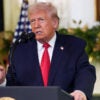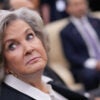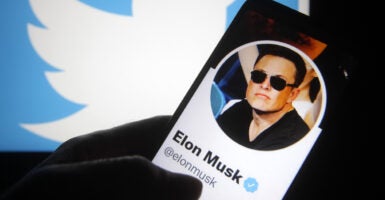The Biden administration’s increasingly aggressive efforts to combat so-called misinformation, along with the prospective acquisition of Twitter by free speech advocate Elon Musk, have sparked a national debate about what role, if any, the government should play in censoring social media.
While some have applauded the administration’s campaign to police online “misinformation” about COVID-19 and other subjects, including through its recent creation of a “Disinformation Governance Board” within the Department of Homeland Security, others have harshly criticized the notion that the government should be the arbiter of truth.
As these critics have observed, many views derided as COVID-19 “misinformation” in 2020 or 2021—for instance, that the virus originated in a lab and that community masking appears to be relatively ineffective—are now gaining traction in mainstream circles.
Likewise, government officials, including President Joe Biden and Centers for Disease Control and Prevention Director Rochelle Walensky, have made claims that later turned out to be untrue, such as that the vaccines reliably stop transmission and that masks are 80% effective at preventing infection.
These revelations have prompted many discerning Americans to question the notion that anyone—whether the government or tech companies—should be allowed to control information shared on social media. Indeed, the understanding that no one has a monopoly on the truth, and that governments are themselves prone to bias and disseminating falsehoods, is a primary reason the Framers included the First Amendment in the Bill of Rights.
Yet in the same week, four separate lawsuits brought on behalf of suspended Twitter users challenging such censorship on First Amendment grounds were dismissed in federal courts, including one brought by former President Donald Trump.
(The author is the lead attorney on one of these cases, Changizi, et al v. Department of Health and Human Services, et al. One of the four, brought by former New York Times journalist and well-known lockdown skeptic Alex Berenson, was permitted to proceed on breach of contract theories—the First Amendment claim was dismissed, as it was in the other lawsuits).
Three of the four lawsuits—all except Trump’s—were premised on versions of the theory that social media censorship is effectively state action, due to pressure exerted on companies by the federal government to quell the spread of “misinformation.”
Plaintiffs pointed to myriad statements by Biden administration officials and congressional Democrats, beginning as early as December 2020, threatening to hold social media platforms “accountable” or “liable” if they do not censor users who spread virus “misinformation.”
Further, former White House press secretary Jennifer Psaki and DHS Secretary Alejandro Mayorkas have stated in no uncertain terms that the administration has ordered social media companies to remove certain problematic posts.
As evidence the government is unlawfully coercing tech companies, some plaintiffs referenced Surgeon General Vivek Murthy’s March 2022 request for information. It demands that tech companies—from social media platforms to e-commerce websites to search engines—turn over (among other things) the identity of purveyors of COVID-19 misinformation.
Many have viewed the benignly named “request” as a threat to impose regulation absent compliance from tech companies, particularly in conjunction with the warnings described above.
Social media platforms like Twitter face pressure to curry favor with the government to avoid adverse consequences, plaintiffs argue, so censoring users for voicing views the government disfavors on COVID-19 violates the First Amendment.
So far, courts have rejected this argument. They have reasoned that officials’ threats of regulatory action or liability for spreading “misinformation” do not establish that any plaintiff was censored because of the government. Twitter, courts surmise, may well have chosen to censor plaintiffs regardless of what Biden, Murthy, and Mayorkas say, vitiating any First Amendment claim.
This reasoning is misguided. First, evidence indicates censorship of plaintiffs’ accounts resulted from government intervention. Only after the administration began its public campaign, in the first months of 2021, was my client, Mark Changizi, suspended for tweeting that masks do not work, the flu is more deadly to children than COVID-19, and asymptomatic individuals rarely spread the virus, despite posting near-identical content throughout 2020.
Michael Senger and Daniel Kotzin, two other clients, were suspended immediately after the surgeon general’s March 3 request for information. None of the three was ever suspended prior to the Biden administration’s threat to punish noncompliant technology companies.
Twitter users noticed a significant uptick in permanent suspensions among those who questioned the government’s approach to COVID-19 beginning about a year ago, as several plaintiffs attested in declarations appended to their lawsuits.
Of course, a jury might find this proof of causation insufficient. But courts are wrong to require stronger factual evidence at the pleading stage. To survive a motion to dismiss, a plaintiff need only establish a plausible inference that the facts, construed in the light most favorable to him, support a claim that would entitle him to the relief requested.
Given threatening statements made by various government actors, admissions that they have orchestrated removal of disfavored posts from social media, establishment of a “Disinformation Governance Board,” and demands that social media companies turn over information about purveyors of misinformation, there is a plausible inference that the plaintiffs’ accounts were censored by state action.
Furthermore, information obtained via discovery could substantiate the inference that social media companies are doing the government’s bidding, and not acting (solely) of their own volition. Indeed, as noted in a letter a congressional subcommittee sent to Biden in December 2020, this degree of censorship runs counter to social media platforms’ financial incentives.
Granting a motion to dismiss means a case cannot proceed to discovery and puts lawyers bringing these cases in a Catch-22: Courts will not allow them to obtain the very discovery the courts deem necessary to establish causation.
Notably, a Freedom of Information Act request made by attorneys in one of these cases has been answered with a perfunctory disclaimer that a backlog of thousands of cases means that it may take two years for the request to be fulfilled (Changizi v. HHS).
Finally, assuming for the sake of argument that the government is not responsible for these specific instances of censorship, the administration’s acts nonetheless chill speech. Knowing that Twitter, Facebook, and YouTube are under significant pressure from the government to silence them, these plaintiffs have attested they self-censor in order to avoid losing their accounts. That alone suffices to establish injury in the First Amendment context.
The court’s dismissal of these lawsuits is unfair not only to the individual plaintiffs, but to the American people, who deserve government transparency.
The Biden administration has, at every juncture and in every manner possible, blocked efforts to shed light on its actions, and district court rulings are enabling the blackout. If the courts of appeals do not see things differently, the First Amendment may very well be dead on arrival in the digital age.
The Daily Signal publishes a variety of perspectives. Nothing written here is to be construed as representing the views of The Heritage Foundation.
Have an opinion about this article? To sound off, please email [email protected] and we’ll consider publishing your edited remarks in our regular “We Hear You” feature. Remember to include the URL or headline of the article plus your name and town and/or state.































